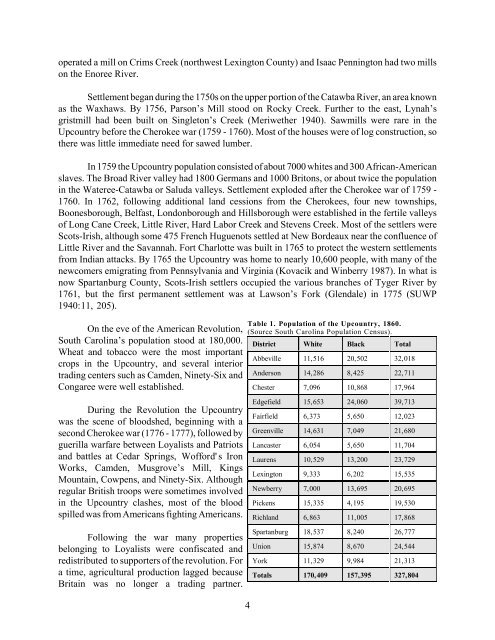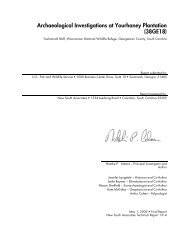Mills in the Upcountry: a Historic Context, and a Summary of a Mill ...
Mills in the Upcountry: a Historic Context, and a Summary of a Mill ...
Mills in the Upcountry: a Historic Context, and a Summary of a Mill ...
You also want an ePaper? Increase the reach of your titles
YUMPU automatically turns print PDFs into web optimized ePapers that Google loves.
operated a mill on Crims Creek (northwest Lex<strong>in</strong>gton County) <strong>and</strong> Isaac Penn<strong>in</strong>gton had two mills<br />
on <strong>the</strong> Enoree River.<br />
Settlement began dur<strong>in</strong>g <strong>the</strong> 1750s on <strong>the</strong> upper portion <strong>of</strong> <strong>the</strong> Catawba River, an area known<br />
as <strong>the</strong> Waxhaws. By 1756, Parson’s <strong>Mill</strong> stood on Rocky Creek. Fur<strong>the</strong>r to <strong>the</strong> east, Lynah’s<br />
gristmill had been built on S<strong>in</strong>gleton’s Creek (Meriwe<strong>the</strong>r 1940). Sawmills were rare <strong>in</strong> <strong>the</strong><br />
<strong>Upcountry</strong> before <strong>the</strong> Cherokee war (1759 - 1760). Most <strong>of</strong> <strong>the</strong> houses were <strong>of</strong> log construction, so<br />
<strong>the</strong>re was little immediate need for sawed lumber.<br />
In 1759 <strong>the</strong> <strong>Upcountry</strong> population consisted <strong>of</strong> about 7000 whites <strong>and</strong> 300 African-American<br />
slaves. The Broad River valley had 1800 Germans <strong>and</strong> 1000 Britons, or about twice <strong>the</strong> population<br />
<strong>in</strong> <strong>the</strong> Wateree-Catawba or Saluda valleys. Settlement exploded after <strong>the</strong> Cherokee war <strong>of</strong> 1759 -<br />
1760. In 1762, follow<strong>in</strong>g additional l<strong>and</strong> cessions from <strong>the</strong> Cherokees, four new townships,<br />
Boonesborough, Belfast, Londonborough <strong>and</strong> Hillsborough were established <strong>in</strong> <strong>the</strong> fertile valleys<br />
<strong>of</strong> Long Cane Creek, Little River, Hard Labor Creek <strong>and</strong> Stevens Creek. Most <strong>of</strong> <strong>the</strong> settlers were<br />
Scots-Irish, although some 475 French Huguenots settled at New Bordeaux near <strong>the</strong> confluence <strong>of</strong><br />
Little River <strong>and</strong> <strong>the</strong> Savannah. Fort Charlotte was built <strong>in</strong> 1765 to protect <strong>the</strong> western settlements<br />
from Indian attacks. By 1765 <strong>the</strong> <strong>Upcountry</strong> was home to nearly 10,600 people, with many <strong>of</strong> <strong>the</strong><br />
newcomers emigrat<strong>in</strong>g from Pennsylvania <strong>and</strong> Virg<strong>in</strong>ia (Kovacik <strong>and</strong> W<strong>in</strong>berry 1987). In what is<br />
now Spartanburg County, Scots-Irish settlers occupied <strong>the</strong> various branches <strong>of</strong> Tyger River by<br />
1761, but <strong>the</strong> first permanent settlement was at Lawson’s Fork (Glendale) <strong>in</strong> 1775 (SUWP<br />
1940:11, 205).<br />
On <strong>the</strong> eve <strong>of</strong> <strong>the</strong> American Revolution,<br />
South Carol<strong>in</strong>a’s population stood at 180,000.<br />
Wheat <strong>and</strong> tobacco were <strong>the</strong> most important<br />
crops <strong>in</strong> <strong>the</strong> <strong>Upcountry</strong>, <strong>and</strong> several <strong>in</strong>terior<br />
trad<strong>in</strong>g centers such as Camden, N<strong>in</strong>ety-Six <strong>and</strong><br />
Congaree were well established.<br />
Table 1. Population <strong>of</strong> <strong>the</strong> <strong>Upcountry</strong>, 1860.<br />
(Source South Carol<strong>in</strong>a Population Census).<br />
District White Black Total<br />
Abbeville 11,516 20,502 32,018<br />
Anderson 14,286 8,425 22,711<br />
Chester 7,096 10,868 17,964<br />
Dur<strong>in</strong>g <strong>the</strong> Revolution <strong>the</strong> <strong>Upcountry</strong><br />
was <strong>the</strong> scene <strong>of</strong> bloodshed, beg<strong>in</strong>n<strong>in</strong>g with a<br />
second Cherokee war (1776 - 1777), followed by<br />
guerilla warfare between Loyalists <strong>and</strong> Patriots<br />
<strong>and</strong> battles at Cedar Spr<strong>in</strong>gs, W<strong>of</strong>ford' s Iron<br />
Works, Camden, Musgrove’s <strong>Mill</strong>, K<strong>in</strong>gs<br />
Mounta<strong>in</strong>, Cowpens, <strong>and</strong> N<strong>in</strong>ety-Six. Although<br />
regular British troops were sometimes <strong>in</strong>volved<br />
<strong>in</strong> <strong>the</strong> <strong>Upcountry</strong> clashes, most <strong>of</strong> <strong>the</strong> blood<br />
spilled was from Americans fight<strong>in</strong>g Americans.<br />
Follow<strong>in</strong>g <strong>the</strong> war many properties<br />
belong<strong>in</strong>g to Loyalists were confiscated <strong>and</strong><br />
redistributed to supporters <strong>of</strong> <strong>the</strong> revolution. For<br />
a time, agricultural production lagged because<br />
Brita<strong>in</strong> was no longer a trad<strong>in</strong>g partner.<br />
Edgefield 15,653 24,060 39,713<br />
Fairfield 6,373 5,650 12,023<br />
Greenville 14,631 7,049 21,680<br />
Lancaster 6,054 5,650 11,704<br />
Laurens 10,529 13,200 23,729<br />
Lex<strong>in</strong>gton 9,333 6,202 15,535<br />
Newberry 7,000 13,695 20,695<br />
Pickens 15,335 4,195 19,530<br />
Richl<strong>and</strong> 6,863 11,005 17,868<br />
Spartanburg 18,537 8,240 26,777<br />
Union 15,874 8,670 24,544<br />
York 11,329 9,984 21,313<br />
Totals 170,409 157,395 327,804<br />
4







